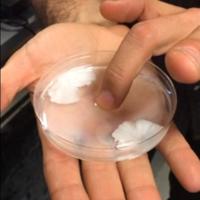
Mar 13, 2014
Okay, so it's not reallllllyyy ice, as you know ice to be.
BUT, while we were at Rockefeller University, seeing just how fast water can change into ice for our podcast, Super Cool, our lab team showed us something else crystallizing -- sodium acetate.
What the hell is happening in that petri dish?
I asked Alexander Petroff, our intrepid lab leader (and also the Raymond and Beverly Sackler Fellow, at Rockefeller University) to explain:
"The basic idea is exactly the same as the super cooled water. In the case of the ice, the water was cooled below its freezing temperature. Because there was nothing for large ice crystals to form around, the water stayed a liquid until we gave it something to freeze around. In the case of the sodium acetate, we dissolved more sodium acetate into the water than the water could hold. However, because there was nothing in sodium acetate crystals to form around, all of it stayed dissolved until Jad put his finder into it. The sodium acetate crystals formed around Jad's finger, just like at night, extra water forms as dew around things like spider webs and grass."
Moreover, the petri dish becomes hot as it happens (even though we're talking about ice, which we think of as cold, it's an exothermic reaction), and the "ice" actually feels not hard, but firmly soft, like a gel.
You blew our mind, Petroff, you blew.our.mind.
Here's how they did it?
Says Alex:
"First of all, you need sodium acetate. It is the flavoring that people use to give salt and vinegar chips their taste. Our lab had a convenient jar full of the stuff, so that is what I used (you can buy it online). If you wanted to make your own, it is simple to do. When you mix vinegar (acetic acid) and baking soda (sodium bicarbonate), the sodium and the acetic acid team up to make sodium acetate. The bicarbonate that is left over turns to carbon dioxide and makes all of the bubbles that powered our toy volcanoes.
Now that you have your sodium acetate, you need to get more of it dissolved into the water than the water can hold (i.e., make the water "super saturated"). You can do this by using the convenient fact that when you heat up water it can hold more sodium acetate (and lots of other things) than it can when it's cold or at room temp.
To super saturate the water with sodium acetate, take a jar of water and heat it up close to the boiling temperature. Keep on pouring in sodium acetate until it stops dissolving. Because it stopped dissolving, you know that the hot water is saturated. Because hot water holds more sodium acetate than cold water, as the water cools off it became super saturated. I cooled it off by putting it into the fridge and letting it cool down to about 4C. At this point, we had a dish of water super saturated with sodium acetate. I handed if to Jad and, when he put his finger into it, the the sodium acetate began to form crystals."
Dear listeners, if you try doing this at home, send us some photos/videos, yah?!